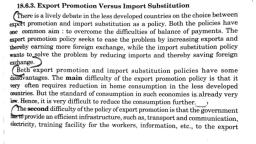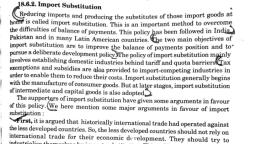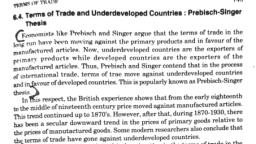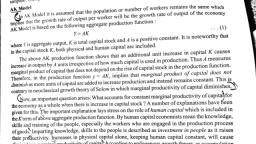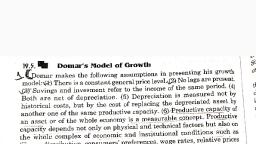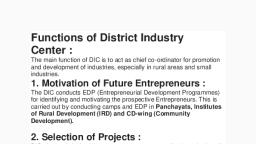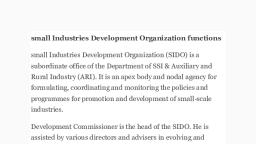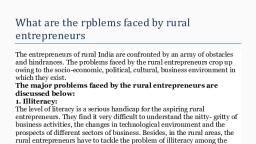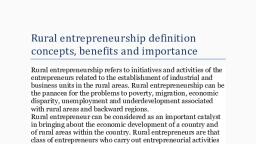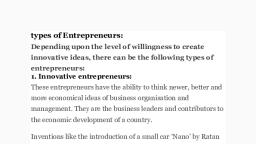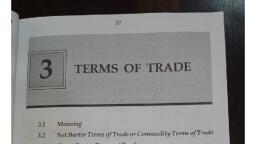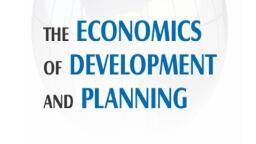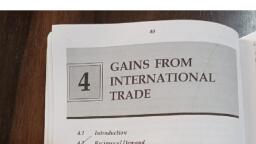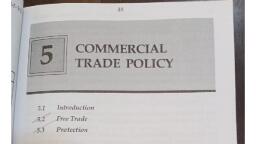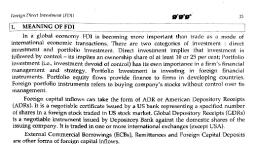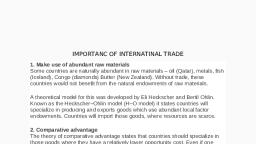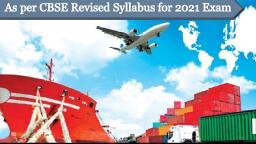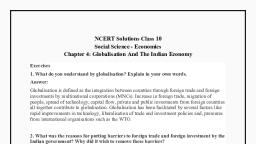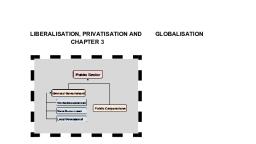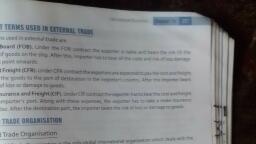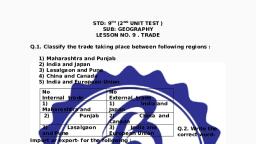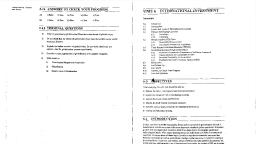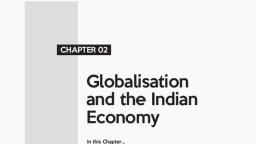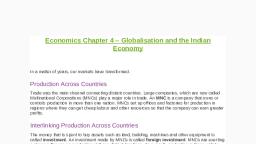Page 1 :
The Role of Trade in Economic Development:, In discussing the role of trade in fostering economic development, we have to examine, various different issues, viz, the static effects of trade, the dynamic effects of trade and, export pessimism or secular deterioration of the terms of trade of LDCs. In this context,, we have access to discuss trade policies of the developing countries., 1. The Static Effect of Trade on Economic Development:, International trade enables an LDC to get beyond its PPC and improve its welfare. It can, consume more than what it is capable of producing through specialisation and, exchange. An LDC can improve its well-being by specialising in and exporting the, relatively less expensive domestic goods and importing goods which are relatively more, expensive. Even if a country’s production does not change at all, there are still gains, from exchange if there is a difference between internal relative prices in autarky and, those which can be obtained internationally., In addition, the characteristics of the imported goods either in terms of quantity for, customers or productivity in the case of capital and intermediate imports, may improve, the economy ‘s ability to meet consumer desires for better quality goods or larger, volume of goods made available by improved technology. Imports may also help remove, bottlenecks and enable the economy to operate closer to its PPC—that is to say, more, efficiency on a consistent basis., i. Employment Generation:, Due to specialisation there is a relative expansion of the sectors using relatively more, intensively an LDCs abundant factor—which is labour. For most LDCs, specialisation, according to comparative advantage helps to expand labour-intensive production, instead of more modern, capital-intensive production., This means expanding traditional agriculture, primary products, and labour-intensive, light manufactures. International trade thus stimulates employment and puts upward, pressure on wages as has been suggested by the Heckscher-Ohlin (H-O) theorem., However, most LDCs are labour-surplus countries. So, an increased demand for labour, is unlikely to raise the wage rate much., ii. Export Instability:, Moreover, the relative growth in the production of traditional goods may not be, desirable if such growth is at the expense of modern manufacturing. Due to low income, and price elasticities of demand for such goods and the instability of supply of agricultural and primary products due to natural (weather) conditions, greater specialisation, in these goods can result in a greater instability of income even in the short run., iii. Adverse Terms of Trade:, In addition, since an LDC is a small country (in the sense that it cannot exert any, influence on the prices of its exports and imports), expansion of export supply may lead, to undesired terms of trade movements that will-reduce the static gains from trade., This may lead to a distribution of gains from trade in favour of the industrially, developed countries., 2. The Dynamic Effects of Trade on Economic Development:, Perhaps the maximum potential impact of trade on development lies in its dynamic, effects. As D. Salvatore has put’ it- “While the need for a truly dynamic theory cannot be, denied, comparative statics can carry us a long way forward incorporating dynamic, changes in the economy into traditional trade theory. As a result, traditional trade, theory, with certain qualifications, is of relevance even for developing nations and the, development process.”, On the positive side, the expansion of output made possible by access to the wider, international markets enables the LDC to exploit economies of scale that would not be, possible with a narrow domestic market.
Page 2 :
This means that industries which are not internationally competitive in an isolated, market may achieve competitiveness by way of international trade if there are potential, economies of scale. If LDCs can take advantage of economies of scale, they can reduce, costs of production and sell their products at low prices in international market., Promotion of Infant Industries:, Moreover, comparative advantage is a dynamic concept. In the real world, we find, changing pattern of comparative advantage over time. As a developing nation, accumulates capital and improves its technology, its comparative advantage shifts away, from primary products to simple manufactured goods first and then to more, sophisticated ones., Thus, with economic development, international trade can foster the development of, infant industries and make them internationally competitive by providing the market, size and exposure to products and processes that is unlikely to happen in closed, (isolated) economy. This is why the most important argument for protection in LDCs is, the infant industry argument. It is essentially an argument in favour of protection to, gain comparative advantage., This is why for protecting infant industries trade policy restraints in most LDCs are, used, at least in the early stages to restrict imports or promote exports. To some extent,, this has already happened in Brazil, Korea, Taiwan, Mexico and some other developing, countries. However, there are various problems with using the policy in practice., Infants never grow adult in some high protected environments and there is need for, continuation of protection for ever., Other Dynamic Influences:, Perhaps the maximum possible impact of trade on development depends on its dynamic, effects. Prima facie, the expansion of output brought along by access to the larger, international markets permits the LDC to take advantage of economies of scale that do, not arise in the limited domestic market., ADVERTISEMENTS:, , Thus, industries which are not internationally competitive in a narrow and isolated, domestic market may well gain competitiveness as a wider market created by, international trade. Trade creates an opportunity to exploit potential economies of, scale. Furthermore, comparative advantage keeps on changing over time., Thus, as economic development takes place, international trade promotes the growth, and ensures the maturity of infant industries which become internationally competitive, by being able to exploit the wider market created by trade., A wider market also exposes an LDCs products and processes in international market, and creates pressure on the industries of LDCs to improve product quality and reduce, product price so that these are accepted in the rest of the world. In short, international, trade makes protected domestic industries internationally competitive., Other dynamic influences of trade on economic development arise from the positive, competitive effects of trade, increased investment resulting from changes in the, economic environment; the increased dissemination of technology into the LDC (as has, been suggested by the product life cycle model), exposure to new and improved, products and changes in institutions accompany the increased exposure to different, countries, cultures and products. Trade fosters domestic competition and acts as an, instrument of controlling monopoly., Openness to trade can affect the technology that a-country can use. We may now discuss, the mechanism in detail. Trade policies give of country access to new and improved, products. No doubt capital goods are an important type of input into production that is
Page 3 :
largely imported by LDCs at lower stages of development. Trade allows a country to, import new and improved capital goods, which “embody” better technology that can be, used in production to raise total factor productivity., The foreign exporters can also enhance the process, for instance, by advising the, importing firms on the best ways to use the new capital goods. Some empirical studies, show that the gains from being able to import unique foreign imports that embody new, technology can be larger than the traditional gains from trade, highlighted by the, classical theory., According to T. A. Pugel, in a more general way, openness to international activities, leads the firms and people of the country to have more contact with technology, developed in other countries. This greater awareness makes it possible for an LDC to, gain the use of new technology—through purchase of capital goods or through licensing, or initiation of the technology., Great economic openness is likely to have a favourable effect on the incentive to, innovate. Trade is likely to put additional competitive pressure on the country’s firms., The pressure drives the firms to seek better technology to raise their productivity in, order to achieve greater international competitiveness., Trade also provides a larger market in which to earn returns to innovation. Its sale into, foreign markets provides additional returns, then the incentive to innovate increases,, and firms devote more resources to R & D activities., Openness thus can enhance the technology that a country can use—both by facilitating, the diffusion of imported technology into the country and by accelerating the, indigenous development of technology. Furthermore, these increases in current, technology base can be used to develop additional innovations in the future., The current technology base becomes a potent source of increasing returns over time to, ongoing innovation activities. The growth rate for the country’s economy (and for the, world as a whole) increases in the long run., In short, economic openness can accelerate long-run economic growth. This indicates, an additional source of gains from international trade (or from openness to, international activities more generally). Empirical studies show that there is a strong, positive correlation between the growth rate of a country and its international, openness. This is not a proof of causation, ‘but it is consistent with the theoretical, analysis that suggests why openness can raise growth., However Trade can also act as hindrance to growth, The important harmful effects of trade are the following:, 1. Trade may lead to indiscriminate exploitation of natural resource, particularly of, developing nations. Trade has been resulting in the drain of resources from the, developing to developed countries., 2. Trade also causes environmental problems because of the indiscriminate, exploitation of resources and location/relocation of polluting and hazardous industries, in the developing world for the benefit of the developed world., 3. The deterioration of the terms of trade of the developing countries causes large, income transfers from the developing to the developed countries., International trade may also give rise to demonstration effect in the developing, countries. Demonstration effect, a term associated with Nurkse, refers to the tendency, of poor people to imitate the life styles of the rich.
Page 4 :
In international economics, it refers to the tendency of the people of developing, countries to follow the consumption habits of the people of the advanced countries by, importing luxury goods. This could have harmful social and economic effects. It could, also have some favourable effect if it can encourage the development of the domestic, industries of the developing countries., Another important harmful effect of trade is what is described as the backwash effect., Some of the domestic industries of the developing countries, particularly small scale,, which are unable to compete with the well-developed industries of the advanced, countries, could be destroyed or damaged by unregulated imports.

